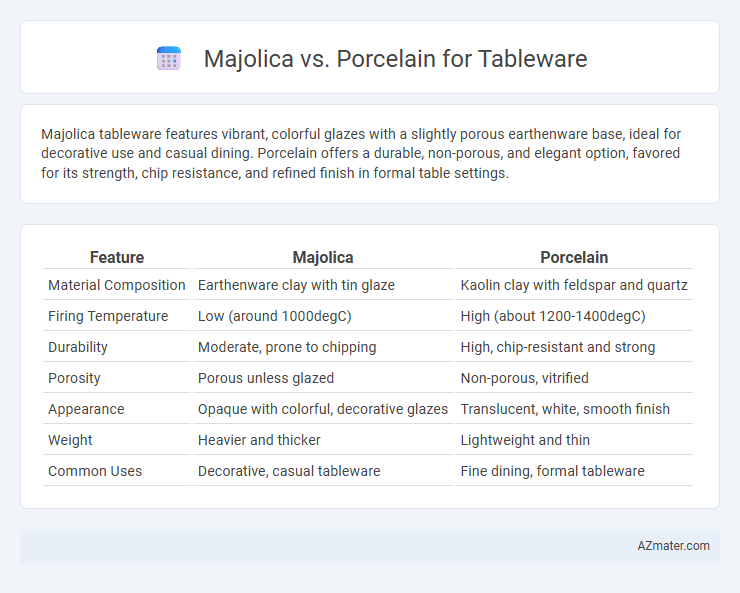Majolica tableware features vibrant, colorful glazes with a slightly porous earthenware base, ideal for decorative use and casual dining. Porcelain offers a durable, non-porous, and elegant option, favored for its strength, chip resistance, and refined finish in formal table settings.
Table of Comparison
| Feature | Majolica | Porcelain |
|---|---|---|
| Material Composition | Earthenware clay with tin glaze | Kaolin clay with feldspar and quartz |
| Firing Temperature | Low (around 1000degC) | High (about 1200-1400degC) |
| Durability | Moderate, prone to chipping | High, chip-resistant and strong |
| Porosity | Porous unless glazed | Non-porous, vitrified |
| Appearance | Opaque with colorful, decorative glazes | Translucent, white, smooth finish |
| Weight | Heavier and thicker | Lightweight and thin |
| Common Uses | Decorative, casual tableware | Fine dining, formal tableware |
Introduction to Majolica and Porcelain Tableware
Majolica tableware is characterized by its vibrant, hand-painted glaze on earthenware, offering a rustic yet colorful aesthetic that enhances casual and traditional dining settings. Porcelain tableware, made from fine kaolin clay fired at high temperatures, provides a durable, translucent, and elegant finish ideal for formal occasions and modern kitchens. Both materials differ significantly in texture, strength, and visual appeal, influencing their suitability for varied tableware uses.
Historical Origins and Evolution
Majolica originated in the Renaissance era as tin-glazed earthenware known for its vibrant colors and intricate patterns, primarily produced in Italy and later spreading across Europe. Porcelain, developed earlier in China during the Tang dynasty and later refined in the Ming dynasty, is prized for its durability, translucency, and smooth white surface, becoming a symbol of luxury worldwide. Over centuries, both Majolica and Porcelain tableware evolved to blend artistic expression with functional use, influencing design trends and craftsmanship techniques globally.
Material Composition and Manufacturing Processes
Majolica tableware is crafted from earthenware clay coated with a tin glaze that creates a bright, opaque surface ideal for colorful decoration, while porcelain is made from a mixture of kaolin, feldspar, and quartz fired at higher temperatures for a dense, translucent finish. The low firing temperature of Majolica results in a more porous and less durable material compared to the vitrified, non-porous structure of porcelain. Manufacturing Majolica involves applying a lead or tin-based glaze followed by hand-painting, whereas porcelain undergoes precision molding, high-temperature firing, and often glazing or decoration through advanced techniques like decal application or underglaze painting.
Visual and Aesthetic Differences
Majolica tableware features vibrant, hand-painted glazes with intricate patterns and a glossy finish that highlights its rustic charm and historic appeal. Porcelain, on the other hand, offers a smooth, translucent surface with refined elegance, often characterized by delicate, subtle designs and a more polished, minimalist look. The bold, colorful aesthetics of Majolica contrast sharply with the sleek, often white or neutral tones of porcelain, making each ideal for different decorative preferences and dining atmospheres.
Durability and Longevity Comparison
Majolica tableware, made from earthenware clay and coated with a tin glaze, offers vibrant colors but tends to be less durable than porcelain due to its porous and softer composition. Porcelain, crafted from refined kaolin clay and fired at higher temperatures, provides superior strength, chip resistance, and longevity, making it ideal for frequent use. While majolica is prone to cracking and wear over time, porcelain tableware maintains its structural integrity and aesthetic appeal for decades under regular use.
Everyday Use and Practicality
Majolica tableware offers vibrant, hand-painted designs with a porous glaze that requires careful handling and is prone to chipping, making it less ideal for everyday use. Porcelain, known for its durability, non-porous surface, and resistance to scratches and stains, provides a practical option for daily dining and frequent dishwasher use. The heat retention and lightweight properties of porcelain enhance convenience, while Majolica's decorative appeal suits occasional, stylish settings rather than rigorous daily use.
Care, Cleaning, and Maintenance
Majolica tableware requires gentle hand washing with mild soap to preserve its vibrant, often hand-painted glaze and prevent chipping. Porcelain is more durable and dishwasher-safe, allowing for easier cleaning while resisting scratches and stains over time. Proper storage, such as cushioning between pieces, is essential for both materials to maintain their aesthetic and structural integrity.
Cost Analysis and Value for Money
Majolica tableware generally costs less than porcelain due to its thicker, less refined clay body and simpler glazing process, making it an affordable option for colorful, decorative dining sets. Porcelain offers higher durability, chip resistance, and a more delicate appearance, which justifies its higher price point for luxury or formal table settings. When considering value for money, buyers seeking long-lasting, elegant tableware benefit from investing in porcelain, while majolica fulfills the demand for cost-effective, artisanal-style pieces ideal for casual use.
Pros and Cons: Majolica vs Porcelain
Majolica tableware offers vibrant, hand-painted designs and a porous surface that enhances natural glaze effects but requires careful handling to avoid chipping and staining. Porcelain provides exceptional durability, a non-porous surface ideal for hygiene, and a sleek, elegant appearance, though it can be more expensive and prone to visible wear over time. Choosing between Majolica and Porcelain depends on balancing aesthetic appeal and maintenance needs against durability and long-term usage.
Choosing the Right Tableware for Your Needs
Majolica tableware, known for its vibrant, hand-painted glaze and earthenware base, offers a rustic charm perfect for casual, decorative use, while porcelain, prized for its durability, translucency, and non-porous surface, suits both everyday dining and formal occasions. Choosing between majolica and porcelain depends on factors like desired aesthetics, resistance to chipping, dishwasher safety, and the level of formality required for your table settings. For long-lasting, versatile tableware that withstands frequent use, porcelain is ideal, whereas majolica adds artistic character and warmth to less routine settings.

Infographic: Majolica vs Porcelain for Tableware
 azmater.com
azmater.com